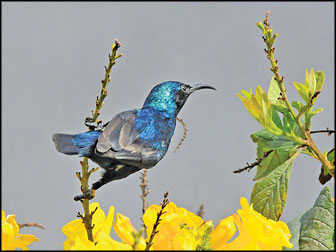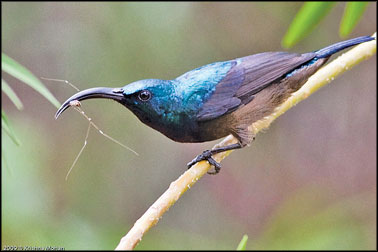The sunbird has lost its wedding suit
by K.G.H. Munidasa
The annual molting season of the sunbirds having commenced, the male
Purple Sunbirds are no longer in their brilliant dress. I observed the
first in "eclipse" or off-season plumage as I took my customary
afternoon wash at the well behind the house, a few days ago. It was in a
Hibiscus plant in bloom, nearby. I was certain that the other with it,
probing the flowers, was its mate or, perhaps a juvenile male. Because,
in the off-season plumage both sexes are much similar in attire, except
for a broad stripe of metallic-blue feathers running down the middle of
the underparts, from chin to abdomen, and a similar coloured patch on
the shoulder of the wings, in the adult male.
 |
|
Lotenís sunbird |
The male of the Loten's Sunbird, more often confused with the other,
does not appear to have an off-season plumage, though I have noted, time
and again, many a juvenile male assuming the eclipse phase, before
molting into full adult plumage.
The Purple Sunbird Cinnyris asiatica asiatica is one of the commonest
birds in the Low-Country Dry Zone and the drier hilly districts, but not
commonly met with in the Low-Country Wet Zone, where its place is taken
by its counterpart, the Loten's Sunbird Cinnyris lotenia lotenia, a race
peculiar to Sri Lanka.
This sunbird has a wide range in Southern Asia, and is divided into
several races. The typical race asiatica occurs in Sri Lanka and
throughout the whole of India, except the north-east.
Among our commoner resident birds, the Purple Sunbird exhibits the
most ingenuity and artistry in the selection of nesting sites and
nest-building. In the Low-Country Dry Zone, I have often come across its
nests places in the cobweb masses of that sociable spider Stegodyphus
serasinorum, which commonly builds its large communal nest in low
bushes. In every such case the sunbirds had simply pressed a hole into
the side of the cobweb-mass and lined the inside with vegetable down and
other soft material, and laid the clutch,. In what manner had they dealt
with the spider landlord, I could not fathom.
In my notebook, there is a record of a nest having been placed in a
bird-lover's trouser pocket, by a hen sunbird. Of course, the trouser in
question was on a clothesline in his verandah.
At a remote village in the Gal Oya Valley, years ago, a pair of
sunbirds attached their quaint nest to the end of a length of coir
string dangling from the roof of a colony-cottage. The site was so
unsafe that a ten year-old could have accidentally damaged the nest by
raising a hand. But the brooding hen seemed to have no concern for the
half-dozen children, who played right beneath her egg chamber.
On another instance, the occupants of a labour-dormitory once tied a
length of coir string between two pillars in the verandah. A pair of
sunbirds on the hunt for nesting sites, selected the string to hang
their nest from. The clothesline was used by workers, day and night, who
always avoided tampering with the nest.
One afternoon I attended a district committee meeting of the Wild
Life and Nature Protection Society of Ceylon, held at the resident of
the Gal Oya District Representative Gamini Punchihewa's residence at
Inginiyagala. After the meeting, Gamini personally called me into their
bed room, and showed me a sunbird's nest attached to a napkin in a
clothesline there. It was a nest of the Purple Sunbird and contained two
eggs. Mrs. Punchihewa told me that the hen sunbird came through the
window and built the nest as they watched in amazement.
A nest I was once taken to in the Ampara town was cunningly attached
to the canopy of a mosquito net that hung overt the bed of a
newly-married couple.
On another instance, a hen Purple Sunbird selected as the site for
her nest a face towel on a clothesline in the back yard of my house. The
towel, quite old and threadbare, was carelessly thrown on the
clothesline by my wife after use, one morning. In the afternoon when I
stepped out to collect the towel, my attention was drawn to a female
sunbird which behaved in an unusual manner. I noticed a nest in the
towel and by then she had built a good part of it, including a little
porch above the entrance on the side.
The next day she busied herself in stuffing the inside with Kapok
wool, collected from somewhere. For greater security she anchored the
nest further with cobweb.
On the morning of the fifth day when I walked up to find out what
progress had she made, I found two speckled eggs inside. After the hen
started sitting, I pulled a loose end of the towel over the nest, taking
care not to obstruct the entrance hole, and secured it with paper pins.
This was a precautionary measure against any possible attack by a
predator.
 |
|
Male Lotenís
sunbird |
Although the nest was a mere three feet above the ground, my
three-year old son, who often stood beneath the nest to watch, did not
disturb the brooding hen at all. Standing on tiptoe he even touched with
his finger-tip her long beak protruding out of the nest. My wife
continued to use the clothesline as usual. On the fourteenth day the
first egg hatched, and following day I was there to witness the birth of
the second thick.
It was in May 1978 that a nesting pair of Purple Sunbirds established
what I presumed to be an all time record in nest-building. Details of
their exploit, which received wide publicity in the journal of the
Bombay Natural History Society is condensed and reproduced here:
One afternoon I noticed a Purple Sunbird clinging to a nightgown on a
clothesline outside our living-room. A closer look revealed that she was
apparently trying to build a nest there, between two folds of the
night-gown. I found a collection of cobwebs and three little egg cocoons
on it. It was late that day to make any further observations.
The following morning, I placed an old canvas, used in deck chairs,
on the clothesline and arranged it in such a way as to leave two
well-formed folds. In between the folds I made a fairly deep "pocket",
using some paper pins. At eight in the evening the same day, I found
that the female sunbird had started a nest in the pocket, using the
usual material. Inside it was profusely stuffed with cotton wool. Eight
days later two eggs were laid and the hen started sitting.
The nest was hardly two feet above the ground. A fortnight later the
eggs successfully hatched, and then the cock started to pay frequent
visits to the nest. On the seventh day I took one chick out of the nest,
but it promptly freed itself and flew away.
I recaptured it and put it back in the nest. Early the following
morning the same chick had left the nest unnoticed, and when my nephew
walked up to the nest the other chick too, left the nest and flew off to
the nearby scrub.
|

